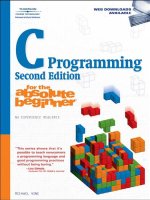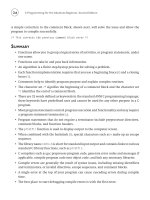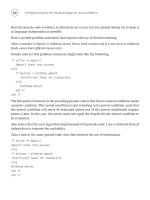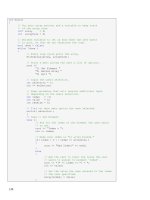C Programming for Scientists & Engineers phần 6 pptx
Bạn đang xem bản rút gọn của tài liệu. Xem và tải ngay bản đầy đủ của tài liệu tại đây (1.05 MB, 15 trang )
Introduction
to
functions
69
fprintf(stdout,"
Co-ordinates (x,y)
of
third
point
(m.):");
fscanf(stdin,"
%lf %lf ",
&triangle_2_ptr->x[2],
&triangle_2_ptr->y[2]);
return;
/*
Function: calculate_area
*/
void calculate_area(struct triangle *triangle_ptr)
{
double
a, /*
distance between
points
1 and 2 */
b,
/*
distance
between
points
2 and 3 */
c,
/*
distance
between
points
3 and 1 7
s;
/*
half perimeter
of
triangle
7
a =
sqrt((triangle_ptr->x[1]
-
triangle_ptr->x[0])
*
(triangle_ptr->x[1]
-
triangle_ptr->x[0])
+
(triangle_ptr->y[1]
-
triangle_ptr->y[0])
*
(triangle_ptr->y[1]
-
triangle_ptr->y[0]));
b =
sqrt((triangle_ptr->x[2]
-
triangle_ptr->x[1])
*
(triangle_ptr->x[2]
-
triangle_ptr->x[1])
+
(triangle_ptr->y[2]
-
triangle_ptr->y[1])
*
(triangle_ptr->y[2]
-
triangle_ptr->y[1]));
c =
sqrt((triangle_ptr->x[0]
-
triangle_ptr->x[2])
*
(triangle_ptr->x[0]
-
triangle_ptr->x[2])
+
(triangle_ptr->y[0]
-
triangle_ptr->y[2])
*
(triangle_ptr->y[0]
-
triangle_ptr->y[2]));
s
=
(a+b+c)/2.0;
triangle_ptr->area
=
sqrt(s*(s-a)*(s-b)*(s-c));
return;
/*
Function: write_area
*/
void write_area(struct triangle triangle_3)
{
fprintf(stdout," Calculated area
is %lf
(m2)\n", triangle_3.area);
return;
70 C
programming
for
scientists
and
engineers
Looking
at
main,
a
variable,
triangle_1,
and a
pointer,
triangle_l_ptr,
are
both declared
to be of
data type
struct
triangle.
Following this,
there
is a
function
prototype statement
for
each
function
that
main
will
use.
These
statements
specify
that
main
will
pass
a
pointer
of
data type
struct
triangle
to
read_points
and
calculate_area.
The
function
prototype
for
write_area
specifies
that main
will
pass
a
variable,
of
type
struct
triangle,
by
value.
All of the
function
prototype
statements
specify
that
no
data
will
be
returned
from any
function
via
their
return
statements.
The first
executable statement
in
main copies
the
address
of
triangle_1
to
triangle_1
_ptr.
This
is
followed
by
statements that call
each
function
in the
required sequence. When
read_points
is
called,
main
passes
the
value
of
triangle_l_ptr
to it.
This passes
triangle_1
by
reference
to
read_points. Note,
at
this stage, that
no
data values
have
been stored
in the
members
of
triangle_1.
However, when
read_points
has
finished,
the x and y
arrays inside
triangle_1
contain
the
co-ordinates
of
three points
defining
a
triangle.
In the
next statement, main calls
calculate_area,
again passing
triangle_1
by
reference.
The
calculate_area
function
uses
the
values
in
the x and
y
arrays
to
calculate
the
area
of the
triangle, storing this
in
the
area
member
of
triangle_1.
Finally,
main
calls
write_area,
this time passing
triangle_1
by
value.
Looking
at the
read_points
function,
when
it is
called
it
copies
the
pointer that
is
passed
to it
into
triangle_2_ptr.
This
is
then used
to
access
the
members
of
triangle_l
and, using
the &
operator, pass
their addresses
to
fscanf.
Note
how
individual elements
of the x and
y
arrays
are
accessed.
Looking
at the
calculate_area
function,
the
pointer passed
to it is
copied into
triangle_ptr,
which
is
then
used
to
access
the
values
in the
elements
of the x and y
arrays inside
triangle_1.
This
data
is
used
to
calculate
the
length
of
each side
of the
specified
triangle,
the
function
storing
the
lengths
in
local variables
a, b and c.
These
are
then
used
to
calculate
the
half perimeter
of the
triangle,
5,
before
calculating
the
triangle area.
The
area value
is
then stored
in the
area
member
of
triangle_1.
The
main
function passes
the
variable
triangle_1
to
write_area
by
value.
This
means that
the
values
of the
members inside
triangle_1
are
copied into
the
members
of
triangle_3.
Within
write_area,
the
value
stored
in the
area
member
of
triangle_3
is
then passed
by
value
to
fprintf,
which displays
it on the
screen.
Introduction
to
functions
71
Tutorial
3.9
Implement
Program
3,9,
making
brief
notes
on its
operation,
Tutorial
3.10
Re-write
Program
3.9 so
that
the
struct
triangle
structure
is
replaced
by
struct
triangle
where
point_1[0]
and
point_1
[I], etc.
hold
the x and y co-
ordinates,
respectively,
for
each
point.
Chapter review
This chapter
has
introduced
the
detailed 'mechanics'
of
using
func-
tions
in C
programs.
All C
programs contain
a
function
called
main.
Many
C
programs
use
main
to
co-ordinate
the use of
other
func-
tions, each
of
these having been designed
to
perform
a
particular
task.
When
a
function
uses another
function,
the
former
is
said
to be
the
calling
function
and the
latter
is the
called function.
A
calling
function
must have
a
function
prototype statement
for
each
function
that
it
will
use. Function prototype statements define
the
interface
between
the
calling
and
called
functions.
The
calling
function
can
give data
to the
called function through
an
argument list, variables being passed
by
value
or by
reference.
In
either case,
the
called
function
makes
a
copy
of
each variable passed
to it. A
function receiving
a
variable that
has
been passed
by
reference
can
change
the
value
of
that variable
in the
calling
function
because both calling
and
called functions have access
to the
location
in
memory
of the
variable.
This
cannot happen
if the
variable
has
been passed
by
value.
72 C
programming
for
scientists
and
engineers
A
called
function
can
pass
a
variable back
to the
calling
function
through
the
return
statement.
In
addition
to
demonstrating
the
mechanics
of
using
functions,
later examples
in
this chapter also
introduced
the use of
functions
as a
means
of
partitioning
a
program
to
reflect
the
intended solution
to a
problem.
Decisions
and
Loops
4.1
Introduction
Programs
are
much more
useful
if
they
can
make decisions about
what
tasks need
to be
performed. Making
a
decision
in a C
program usually involves testing
the
value
of one or
more vari-
ables,
for
example,
'if X is
greater
than
Y
then carry
out
task
1,
else carry
out
task
2'. C
programs
can use a
range
of
tests
to
satisfy
many
different
circumstances.
The
example given above uses
the
if-else
construct
and is
just
about
the
most simple test that
a C
program
can
perform. However,
it is not too
difficult
to
imagine
that, having made this decision, task
1 or
task
2 may
also
be an
if-
else
type
of
test, leading
to the
execution
of
other, more
specialized,
tasks (perhaps including more tests). This
can be
achieved
in C by
using
as
many
nested
if-else
constructs
as
required.
The
switch
construct
is
similar
to the
nested
if-else
but is
more appropriate when
different
tasks must
be
selected
(switch
to)
depending
on the
value
of a
variable. Another type
of
test
is
required when
a
particular task
has to be
performed some
number
of
times.
If the
number
of
times required
is
known
beforehand then
the/or
loop
can be
used.
The
decision that
has to
be
made
in
the/or
loop
involves
testing
a
counter
to see if the
loop
has
been
performed
the
required number
of
times.
There
are
other situations where
a
loop
is
required,
but the
number
of
times
that
the
task
has to be
carried
out is not
known beforehand.
A
simple example
of
this
concerns
reading
input from
the
user,
where
the
user
can
enter
as
many items
of
data
as
they
wish.
For
this
and
many
other
similar situations,
C
provides
the
while
and
the
do-while
loops.
4
74 C
programming
tor
scientists
and
engineers
4.2 The
if-else
construct
The
if-else
construct
in C has the
following
form:
if
(expression)
statement,
else
statement
2
In
this example,
(expression)
is a
decision
that
uses
relational
and
logical
operators (Section 2.3)
to
compare
the
values
of
variables
and
constants.
If
expression
is
TRUE then
its
resultant numerical value
is 1 and
statement
1
is
executed, otherwise
expression
is
FALSE,
with
a
numerical value
of 0, and
statement
2
is
executed. Consider
the
following:
double
temperature,
set_point
=
21.0;
temperature
=
32.0;
if
(temperature
>
set_point)
fprintf(stdout,"lt's
hot
today
!\n");
else
fprintf(stdout,"lt's
cold
today
!\n");
In
this example,
the
if
statement makes
a
decision
by
testing
for
temperature
greater
than
set_point.
If
this
is
TRUE
the
'hot' message
is
displayed. Conversely,
the
test
is
FALSE
if
temperature
is
less than
or
equal
to
set_point,
leading
to the
'cold' message being displayed.
Comparison expressions only compare individual numerical values.
This means that collections
of
values (arrays, data structures
and
char-
acter strings) cannot
be
compared numerically.
For
example, given:
int
a[2J
= {3,
265},
b[2]
=
{302,
0};
if(a<=b)
is not
allowed,
but
if
(a[1]<=
b[1])
is OK
because individual elements
of
each
array
are
compared
Similarly:
char
a[3J="cd",
b[3]="tg";
if(a<=b)
is not
allowed,
but
TEAMFLY
Team-Fly
®
Decisions
and
loops
75
if
(a[1]<=
b[1])
is OK,
since
ASCII
values
of
individual
characters
are
compared
Finally,
it
should
be
noted
that,
if a
particular decision does
not
require
the
else
part
of the
if-else
construct,
it
need
not be
included,
for
example:
int
A
=10,B
= 9;
if
(A
< 15)
changes
the
value
of B if A
satisfies
the
test
B
= 0;
Tutorial
4 .1
Implement
the
"temperature"
example
as a
working
program
that
reads
temperature
values from
the
user
and
displays
the
appropriate
message
on the
screen.
Make
notes
on its
operation*
4.3
Compound
statements
In
many cases,
the
outcome
of a
decision
is
that
a
group
of
state-
ments must
be
executed. This
is
achieved
by
grouping
the
required
statements within'{
}'
brackets
to
form
a
compound statement
or
block,
for
example:
int
get_data_from_user(struct data
*);
int
copy_users_data_to_file(struct
data
*);
int
get_data__from_file(struct
data
*);
struct data *data_ptr;
int
user_data;
if
(user_data
!= 0)
{
get_data_from_user(data_ptr);
copy_users_data_to_file(data_ptr);
}
else
get_data_from_file(data_ptr);
76 C
programming
for
scientists
and
engineers
In
this example,
user_data
is a flag
which
is
used
to
indicate that
data must
be
read either
from
the
user
(if
user_data
is not
equal
to
zero)
or
from
a
file
(if
user_data
is
equal
to
zero).
In
this example,
if
the
test
is
TRUE, data
read
from
the
user
is
stored
in a
file.
This
requires
the use of two
functions,
so
their calling statements
are
enclosed within brackets.
In
those situations where
the
comparison expression compares
one
variable
with
the
value zero,
as
above,
a
short hand notation
can
be
used where
if
(user_data
!= 0) and
if
(user_data)
are
equivalent.
In
other
words, both tests
say 'if
user_data
is not
equal
to
zero then '.
In
contrast
to
this,
the
if
(user_data
== 0)
test
can
also
be
written
as
if
(!user_data),
meaning that
the
comparison expression
is
TRUE
if
the
value
of
user_data
is
equal
to
zero.
Tutorial
4.2
Implement
the
example
in
tills
section
as a
working
program,
replacing
the
function
calls
with
calls
to
fprintf,
so
that
messages
indicating
the
appropriate
action
are
displayed
on
the
screen.
The
user
should
be
prompted
for and
supply
a
value
for
user_data
prior
to the
if-else
construct.
Modify
Che
program
in the
previous
question
so
that
it
calls
the
functions shown
in the
example.
Move
the
calls
to
fprintf
into
the
relevant
functions.
Note
that
this
involves
some
under-
standing
of
functions,
discussed
in
Chapter
$ and
that
you
will
need
to
invent
a
convenient
definition
for
struct
data.
4.4
Nested
if-else
statements
Nested
if-else
statements
can be
used where multiple decisions must
be
made.
For
example, consider
the
situation where
a
process
controller
may
perform either
of
three actions depending
on the
temperature being above
an
upper
set
point, below
a
lower
set
point,
or in
between
the
two. This
can be
programmed
as
follows:
Decisions
and
loops
77
if
(temperature
>
upper_set_
point)
{
report_process('
too_hot");
activate_cooler();
}
else
{
if
(temperature
<
lower_set_point)
{
report_process('too_cold");
activate_heater();
}
else
report_process('
OK");
In
this example,
if the
outcome
of the
first
test
is
FALSE
then
a
further
test must
be
performed
to
decide whether
temperature
is
above
or
below
lower
_set_point.
Hence,
the
statement associated
with
the
else
part
of the first
test
is
another
if
statement.
If the
outcome
of
this test
is
FALSE
then
the final
else
statement
is
executed.
If the
outcome
of the first or
second test
is
TRUE then
the
associated blocks
of
statements
are
carried out. When this
happens,
all of the
subsequent statements
in the
nested
if-else
construct
are
ignored.
Note that
the
second
if-else
construct
is
written
as a
compound statement associated with
else
in the first
test. Whilst this
is not
strictly
necessary
in
this example, nesting
if-
else
constructs within
compound
statements
can be
important
in
more complex decision-making, especially when
if-else
constructs
and if
statements
are
used together.
Computing
efficiency
can be a
significant point when
if-else,
and
especially
when nested
if-else,
constructs
are
used within loops.
If it is
known
that
a
particular outcome
is
more
likely
than
any
other,
it is
more
efficient
to
place
it
with
the first
'if.
78 C
programming
for
scientists
and
engineers
Tutorial
44
Implement
the
'temperature'
example
in
this section
as a
working
program, replacing
the
function
calls
with
calls
to
fprintf,
so
that messages indicating
the
appropriate action
are
displayed
on the
screen.The user should
be
prompted
for and
supply
values
for
temperature,
upper_set_point
and
lower_set_point
prior
to
the
if-else
construct.
Make
notes
on the
program's operation.
Tutorial
4.5
The
program
in the
previous question
will
not be
efficient
if
the
controlled process
is
predominantly
within
the
upper
and
lower
set
points.
Assuming this
to be the
case, re-write
the
program
so
that
it is
more efficient Hint:
you
will
need
to use
the
logical
AND
operator,
&&,
discussed
in
Chapter
2.
Tutorial
4.6
Implement
a
weather
forecasting
program that writes
the
text
shown
in the
rows
and
columns
of the
following
table,
depending
on
values
of
temperature
and
pressure supplied
by
the
user.
Define
high temperatures
to be
above 20.0°C
and
high pressures
to be
above 1000,0 millibar.
High temperature Clear skies and hot
Warm
with
rain
Low
temperature
Clear
skies
and
cold
4.5 The
switch
construct
The
switch
construct
is
similar
to
nested
if-else
statements.
However,
it is
more appropriate than nested
if-else
where different
actions
are
required depending
on an
integer variable
or
expression having
a
range
of
values.
The
switch
construct
is
defined
as
follows:
Decisions
and
loops
79
79
switch(expression)
case constant expression:
statements
case constant expression:
statements
default:
statements
Typically,
expression
in the
switch
statement
is the
name
of an
integer
variable.
Also,
the
subsequent
case
statements
are
always
enclosed
within
'{•••}'
brackets. Each
case
statement consists
of the
actual word
'case',
followed
by an
integer constant
and a
colon. When
the
switch
construct
is
executed,
the
value
of the
expression
in the
switch
statement
is
compared
to the
value
of the
constant expression
in the
first
case
statement.
If the two
values
are
equal then
the
statements
associated
with
the
first
case
statement
are
executed.
By
default,
having executed these statements, processing continues
by
comparing
the
switch expression
with
the
constant expression
in
each
of
the
subsequent
case
statements.
If
only those statements associated
with
a
particular
case
statement
are to be
executed, then
the
final
statement
before
the
next
case
must
be
break;.
The
default
case statement
is
intended
to
capture
all of the
situa-
tions
that
are not
trapped
by any of the
case
statements.
The
default
case
is
optional and,
if
omitted,
the
switch
construct
will
not
perform
any
action
if
none
of the
case
constant expressions agree
with
the
expression
in the
switch
statement.
The
following example demon-
strates
the
switch
construct.
int
user_reply;
int
function_0(void);
int
function_ 1(void);
int
function_2(void);
int
report_input_error(int);
fprintf(stdout,"
Select required function
(0, 1 or
2):");
fscanf(stdin,"
%d", &user_reply);
80 C
programming
for
scientists
and
engineers
switch(user_reply)
{
case
0:
function_0();
break;
case
1:
function_
1();
break;
case
2:
function_2();
break;
default:
report_input_error(user_reply);
The
code
in
this example
is
intended
to
call particular
functions
depending
on the
input supplied
by the
user and, also,
to
detect
user input that does
not
correspond
to any of the
available options.
An
int
variable
is
declared which
will
be
used
to
store
the
user's
input.
Four
functions
are
also declared.
The first
three
of
these
are
to be
used
depending
on the
user's choice. Each returns
an int
type
value
and,
for
simplicity
in
this example,
has a
void argument
list.
The final
function that
is
declared
will
be
called
if the
user's input
does
not
correspond
to any of the
valid options.
The first two
executable statements prompt
the
user
for
their input
and
store
it in
user_reply.
user_reply
then appears
in the
expression
part
of the
switch
statement.
This
means
that
the
value
of
user_reply
will
be
compared
with
the
values appearing
in the
case
statements, starting
at the top
of the
list. Assuming that
a
match
is
found,
the
relevant
function
will
be
called. When
a
function
has
completed
its
task, program control
will
return
to the
break
statement immediately following
the
function
call. This
will
then
take
the
program
to the first
statement
after
the
switch
construct.
If a
match between
user_reply
and any of
the
case
statements cannot
be
found,
the
default
case
is
activated,
calling
the
report
_input_error
function.
Tutorial
4.7
Implement
the
above example
as a
working
program.
Each
of
the three functions, function_1 and
function_2
should
simply
call fprintf to
display
a
message
on the
screen
indicating
which
option
has
been
selected.
The report_input_error function
should
display
a
suitable error message.
Decisions
and
loops
81
Tutorial
4.8
Modify
the
program
in
Tutorial
4,7 so
that
user_reply
is
passed
to
each
function
and its
value
is
displayed
in the
messages
generated
via fprintf.
4.6 The
for
loop
The
for
loop
has the
general form:
for(initialization expression;
termination
expression;
incrementation
expression)
statement
The
intention
of the
for
loop
is to
execute
statement
a fixed
number
of
times. When
the
program arrives
at the
loop
for the first
time,
the
decision
making within
the
loop
is
carried
out in
three steps:
•
initializing
a
counter
in the
initialization
expression;
•
using
the
termination
expression
to
check that
the
counter
has or
has
not
exceeded
a
limiting value;
•
after
executing
statement,
incrementing
the
counter using
the
incrementation expression.
The
termination
expression
and the
incrementation
expression
then
control second
and
subsequent passes around
the
loop.
As an
example, Program
4.1
sums
the
elements
of an
array.
I*
Program
4.1 -
Array
summation
*/
#Include
<stdio.h>
int
main(void)
{
int
a[10]
=
{1,2,3,4,5,6,7,8,9,10};
int
no_numbers
= 10, sum = 0, i;
for(i=0;
i <
no_numbers;
i++)
sum +=
a[i];
82 C
programming
for
scientists
and
engineers
fprintf(stdout,"Sum
of
array
elements
=
%d\n",
sum);
return(0);
Program
4.1
declares
and
initializes
an
integer array,
a,
containing
10
elements.
Three
other
variables
are
also declared.
Firstly,
no_numbers
specifies
the
number
of
elements
in a
that contain
useful
data. Secondly,
sum
will
be
used
as an
accumulator
and is
initialized
to
zero. Thirdly,
the
variable
i
will
be
used
as the
counter
in the
for
loop.
The first
executable statement
is the
for
construct.
Its
use in
Program
4.1
should
be
compared
to its
general
form,
above.
In
Program 4.1,
the
initialization
expression
sets
the
loop
counter,
i, to
zero.
The
counter
is
then compared
with
no_numbers
in the
termination expression.
Since this comparison
is
TRUE,
the
statement
sum + =
a[i];
is
executed. This
simply
adds
together
the
value
of the
current
(i
th
)
array
element
and the
current
value
of
sum,
storing
the
result back into sum. Following this,
i is
incremented
by
1
in the
incrementation expression.
This
is the end of the first
pass
around
the
for
loop.
At the
start
of the
second pass,
i is
compared
to
no_numbers
in the
termination expression.
If
this decision
is
TRUE,
the
controlled statement
is
repeated,
and so on.
Note
that
the
termination
expression
tests
for i
less than
no_numbers.
This
choice
of
initialization
and
termination
expressions
is
guided
by
the use of
array,
a, in the
statement that
the
loop controls.
Remember
that
in C
array elements
are
indexed
from
0. So, the
10
th
element
of a
will
be
element
9.
Hence,
the
loop should stop
after
it
has
processed
the
last element, when
i is
equal
to
no_numbers.
In
Program
4.1
only
one
statement
is
executed under
the
control
of
the for
loop.
In
situations where several statements
need
be
executed,
they must
be
enclosed
within
'{
}'
brackets
to
form
a
compound statement,
as
shown
in
Program 4.2.
/*
Program
4.2 - A
fruit
identification program
*/
#include
<stdio.h>
int
main(void)
{
char
fruit_names[20][20];
int
max_no_fruit
= 20,
no_fruit,
i;
Decisions
and
loops
83
fprintf(stdout,"How
many
fruit
can you
name
(maximum
%d):",
max_no_fruit);
fscanf(stdin,"%d",
&no_fruit);
for(i=0;
i <
no_fruit;
i++)
{
fprintf(stdout,"Name
of
fruit");
fscanf(stdin,"
%s",
fruit_names[i]);
}
fprintf(stdout,"You
have
named
the
following
fruits:\n");
for(i=0;
i <
no_fruit; i++)
fprintf(stdout,"
%s\n",
fruit_names[i]);
return(0);
Although
Program
4.2 may
appear
a
little
silly
in
asking
the
user
to
input
the
names
of
fruits,
it
conveniently demonstrates
the use of
compound statements
in
loops
and
also reveals several important
features
of the
for
loop.
The
program uses
a
for
loop that controls
two
statements,
a
call
to
fprintf
to
prompt
the
user, followed
by a
call
to
fscanf
to
store
the
user's input
in the
array
fruit_names.
Note that
the
fruit
_names
array
is
declared
to
store
a
maximum
of 20
names,
each
containing
up to 19
characters.
Before
executing
the
for
loop,
the
program
needs
to
know
how
many times
the
loop
will
be
executed. This information
is
obtained
from
the
user
via the
calls
to
fprintf
and
fscanf,
prior
to the
for
statement.
Note
how the
message displayed
by the
first
call
to
fprintf
tries
to
limit
the
maximum number
of
names supplied
by the
user,
so
that
they
don't enter more names than
fruit_names
can
store.
The
user
can,
however, enter
any
integer
value
regardless
of the
displayed
message. Suppose that
the
user
types 100.
This
value
is
stored
in
no_fruit,
which also appears
in the
termination expression
of the
for
loop.
This
means
that
the
statements
controlled
by the
loop
will
attempt
to
prompt
the
user
to
supply
100
names, trying
to
store
them
in an
array having
enough
space
for
just
20.
Entering
the
21
st
name
will
corrupt
the
program.
To
trap this problem
it
could
be
argued that
an
additional
if-else
construct could
be
inserted before
the
for
loop. However, this misses
two
very
important points.
Firstly,
if
the
user
can
supply
more than
20
names,
the
initial choice
of 20 for
the
size
of the
fruit
_names
array
forces
an
arbitrary
and
unnecessary









